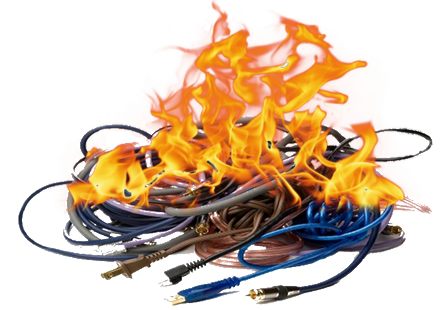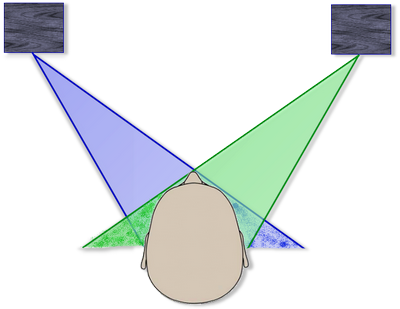 Contact
Home
Chapters
Contact
Home
Chapters
The Listening Test
 If you've been around the audio hobby for more than about 8 minutes, it's likely you've encountered the people comparing high priced wire and cables, adding various doodads to their systems and spending ridiculous amounts of money in the pursuit of perfection. Laughable though it may be, some of these people are intensely dedicated to this activity, believing that it actually makes a difference.
If you've been around the audio hobby for more than about 8 minutes, it's likely you've encountered the people comparing high priced wire and cables, adding various doodads to their systems and spending ridiculous amounts of money in the pursuit of perfection. Laughable though it may be, some of these people are intensely dedicated to this activity, believing that it actually makes a difference.
This rather odd side-group began with the introduction of Monster Cable in 1979. Noel Lee, a mechanical engineer and the company's founder, began experimenting with cables in the belief that it was possible to improve a system's behaviour with patch cords and speaker wires. His first products were initially demonstrated at audio industry conventions and soon became available in an increasing number of stores throughout the US and Canada; always at premium prices.
It wasn't long before Monster's huge profits became known and quite a number of other, even more predatory companies started popping up to sell "High End" accessories. Soon you could buy high end patch cords, speaker wires and power cords. There were accessories like cable lifters, specialty fuses, all kinds of weights and vibration absorbers. They even went after digital cables with high end USB, HDMI and Ethernet cords that purportedly produced better sound quality than "Ordinary" cables. All at High End prices, of course.
Today, this has grown into a multi-billion dollar industry with elaborate websites, inventive science, online reviews, booths at conventions and a large body of "audiophiles" who follow them with constant interest. There are forums, meetings, organized listening sessions and more.
However, all this comes without the first bit of proof that high end cables actually are better. For the most part, the end users take it on faith and promises from the manufacturers.
I hear a difference Home Top Chapters
Devotees of the "cables matter" myth will tell you they know it's true because they can hear a difference between one cable and another. Generally describing an improved "Soundstage" better mid-range clarity, more "Openness" and detail (etc.) in the sound. They will also tell you that measurements don't matter and the only thing that does matter is what they hear.Before we get into this any further I want to be very clear that I do not doubt these people hear differences. I hear them too!
However; we need to take it one step further and ask: "Why?"
What I've learned was something of a surprise...
The demonstrations below require you to listen using speakers.
Protect your hearing, listen at quiet to moderate levels.
Headphones will not adequately demonstrate these effects.
Directionality Home Top Chapters
 The first step is in understanding how we locate sounds in 3d space.
The first step is in understanding how we locate sounds in 3d space.
As the drawing on the right shows, when we hear a sound that is not straight in front of us, we locate it by the difference between our left and right ears.
- The length of the path is different for each ear meaning that a sound on the left will be delayed in reaching our right ear. (and vice versa)
- Because it has to wrap around our head it will be somewhat diffused and lower in amplitude.
- Again because of the delay, phase angles between our left and right ears will also be different.
All of this combines, giving us clues to a sound's origin.
This is easily tested on your own stereo speakers. Just click the Left and Right buttons below and note how easily you locate the speakers by sound.
Stereo imaging Home Top Chapters
 When listening in 2 speaker stereo, the sound field is considerably more complex. Now you have multiple paths and "head shadows" to contend with.
When listening in 2 speaker stereo, the sound field is considerably more complex. Now you have multiple paths and "head shadows" to contend with.
As the diagram shows sound fields from both speakers combine at your ears. But: the path from the left speaker to your right ear is longer than the path to your left ear, the path from the right speaker to your left ear is longer than the path to your right ear and tympanic shadows are created on both sides of your head. The shadow from the left speaker is on the right side and the shadow from the right speaker is on the left.
When the sound is monophonic, these two fields will combine, having equal loudness and equal shadows, to create a "phantom centre" straight in front of the listener. To confirm this simply press the "Phantom centre" button below.
In the recording studio, the mixing engineers can manipulate the apparent position of a sound between (and sometimes beyond) the speakers. This is done by Panning, using an actual knob on the mixing console to adjust the relative loudness of a sound between the speakers and in some cases it also alters the phase relative to the opposing speaker.
To experience this, position yourself in front of your speakers so the phantom centre is straight in front of you and the buttons below will demonstrate a basic five region "soundstage", created simply by panning the sounds.
This is a Psychoacoustic effect that is burned right into each of your recordings. It is obvious your ears are being tricked since, other than left and right, there are no physical sources for the sounds you are hearing.
There are also no hard rules about which instruments are placed in which region and more than five regions are often used for complex recordings. When listening to your "soundstage" you are listening to the engineer's vision of how the music should sound. It is important to note that nothing in your system is creating this effect; it is simply playing what it's given.
The not so sweet spot Home Top Chapters
So, everything we've seen so far is what anyone who has a properly set up system with carefully positioned speakers is expecting. This magical spot where the Phantom Centre signal is dead straight ahead of you is most often called the Sweet Spot, that point where everything comes together to give you the perfect stereo experience.Unfortunately it is not that simple.
If you look at the stereo diagram above 2 things should be obvious.
- First, the distance from each speaker to the opposite ear is longer.
- Second, the dispersion field from one speaker mixes with the direct field from the other.
Since sound travels at a fixed speed that means the longer path results in a delay at the opposite ear. Since it is arriving later, it is also somewhat out of phase. This delayed sound is mixing with the direct sound from the other speaker. At some point these delayed sounds will be phase shifted enough to cause a degree of cancellation, resulting in a dip in the frequency response at the sweet spot. Depending on the size of your head and the angles of your speakers this most often happens in the upper mid-range at about 1,500 to 2,500hz.
This "Mid-Field Cancellation" effect is easily demonstrated using pink and white noise. Press the buttons below, one at a time. Arrange yourself so the phantom centre is straight ahead, then move your head slowly from side to side by a few inches. You will hear the tonality change as you move.
You will also hear other, more subtle, effects by moving forward and back, looking up or down or turning your head toward one speaker or the other.
And, for the record, there is nothing anyone can do about this. Since we all have two ears, spaced some distance apart, we are all effectively listening to two separate locations in the sound field at the same time. This is, quite simply, how our ears and stereo systems work.
Since the common mixing practice is to place solo voices or instruments in that phantom centre position, their sound will be degraded somewhat by the cancellation effect. Moving your head side to side will minimize the effect, giving an apparent improvement in "Clarity" and "Openness" to centred sounds, even in the very best recordings played on the very best systems.
From there it is a very small leap to misattributing the improvement in clarity and openness you heard from a slightly off-centre listening position to whatever doodad you are trying to test on your system.
The attention shift Home Top Chapters
There is a second factor that compounds the Mid-Field Cancellation effect. Very simply: "Are you paying attention?"For this experiment you need to sit in a relatively quiet room and spend a couple of minutes just relaxing and taking in the sound of the room. Don't focus on anything in particular, just listen to the room.
Now, with your thumb and forefinger pull up and back, gently, on your ears and notice how the sound of the room changes. You will likely hear an increase in the mid to high range of sounds and an increased sense of depth.
Next, relax for a minute or so, then pick one sound; a small fan, the ticking of a clock, whatever you choose. Now focus on that sound and notice how the sound of the entire room changes when you do.
This is a natural human reflex. "Pricking one's ears". When we are trying to hear some specific sound we subconsciously move our ears, just a bit, focusing our attention and allowing all the extra sound in as we do.
Of course this happens naturally when we are listening intently for a difference in a cable or some other accessory and, again, it's a very small step to attributing the difference to the cable rather than to focus.
Summing up Home Top Chapters
Listening tests are all well and good, if you are aware of the pitfalls and are very careful to keep a precise listening position and pay careful attention throughout your tests. But, very few people can do this, if they even know about the problems.Most people end up evaluating their listening position instead of the device they are testing.
This is why we measure stuff. With controlled testing we can eliminate all the other variables and get an accurate reading of a device, cord, room, system, whatever.
Noel Lee appears to have found the solution to a problem that nobody actually has.